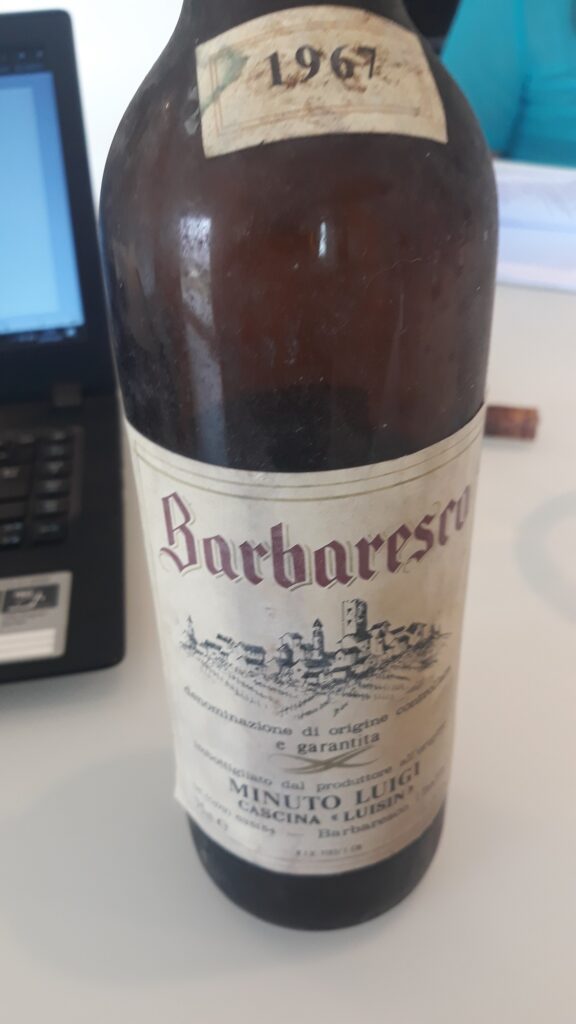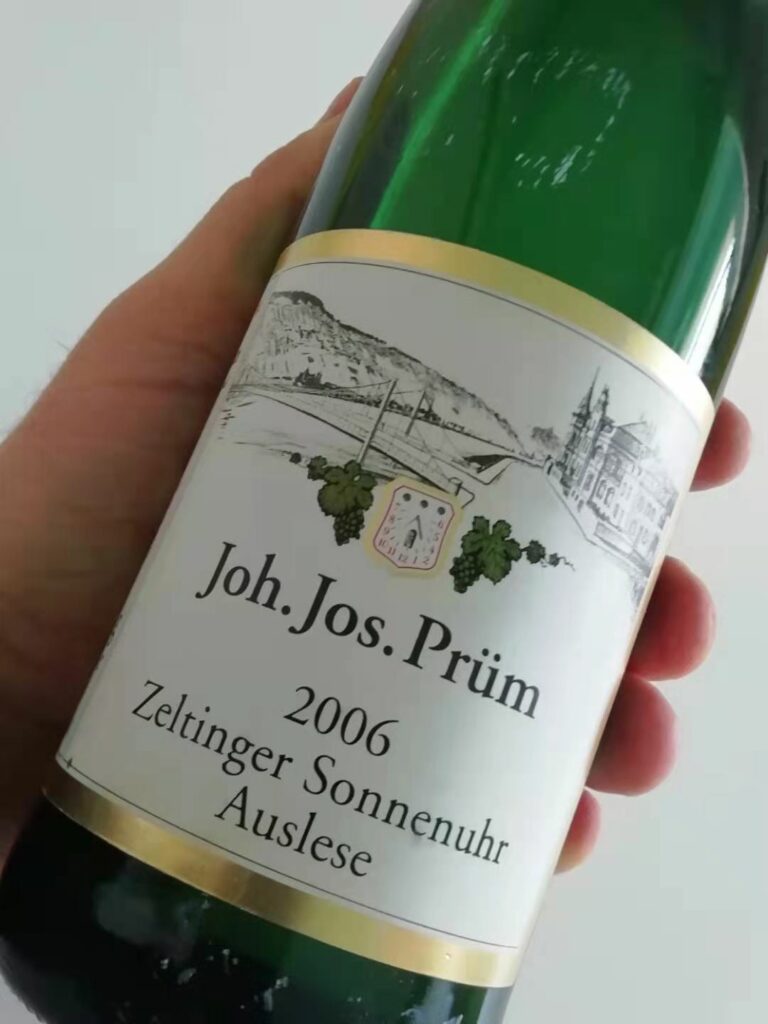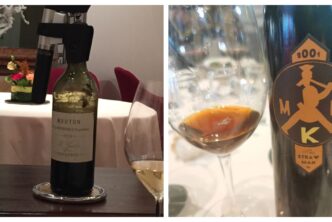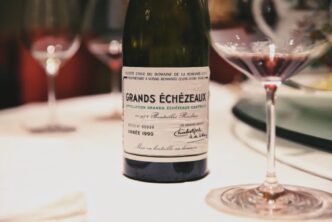1967 Luigi Minuto Cascina Luisin Barbaresco 98

Though this very high quality Barbaresco estate is known today just as Cascina Luisin, it once had another name. Officially founded in 1913 when current owner’s Roberto Minuto great-grandfather Luigi (nicknamed Luisin, hence the original estate name of Luigi Minuto) built the building the winery is housed in, it’s actually nine generations and counting that the Luisin clan has been busy making wines in the area. This is one of the oldest winemaking families of Barbaresco (in fact, it was in the 1950s that Luigi and Mario Minuto split the family estate in two, thereby giving birth to two very well-known and much respected modern-day Barbaresco estates, Cascina Luisin and Moccagatta (clearly, the owner of which also carries the Minuto family name).
At Cascina Luisin they are big believers in the importance of the Barbaresco classico, not at all viewing it as an “entry-level” wine, a common misnomer used today in the misguided belief that single vineyard or cru Barbarescos are always the best of the Barbaresco quality heap. In fact, blending grapes from different communes was always the way in Barbaresco (and Barolo) as it allowed winemakers to pick and choose grapes from those communes where the growing season’s weather had been best. In so doing, wineries were able to make the best possible wine each and every year. In reality, Barbaresco cru wines started appearing only in the 1960s.
At Cascina Luisin, they are very traditional winemakers. For this reason, the estate releases its wines one year later than most people in the area, and uses cement vats in which to carry out the alcoholic fermentation, and chooses to age the wines in large Slavonian oak 20-40 hectoliter barrels for a minimum of 30 months. The estate owns eight hectares practically all planted to nothing but old vines, and makes 45000 bottles a year. Most importantly, Cascina Luisin is, along with Bruno Giacosa, only one of two single-owner estates in all of Barbaresco that makes wines from the commune’s two most prestigious sites, Asili and Rabajà (clearly, the Produttori di Barbaresco does too, but that is a cooperative). Cascina Luisin owns 0.5 hectares of roughly 58 years old vines in Asili and 0.8 hectares of 43 years old vines in Rabajà.
The 1967 Luigi Minuto Cascina Luisin Barbaresco is a work of art, and still remarkably young and vibrant. Tasted along with Roberto Minuto at the cellar during my last visit at the estate during August of Covid-plagued 2020, this is everything a great Barbaresco is all about. Faded rose and violet, red cherry jam, cinnamon and nutmeg, earth tones and tar plus complicating hints of licorice, it boasts fine-grained tannins and harmonious acidity that nicely extends the flavours on the long suave back end. Tasting something this good helps you understand why people fall in love with wine. Drinking window: now-2035 (in a very good cellar).
JJ Prüm 2006 Zeltinger Sonnenuhr Riesling Auslese 94

Joh. Jos. Prüm, or JJ Prüm for short, is one of the world’s thirty or so most famous wine estates. Very few anywhere in the world can boast hundreds of years of uninterrupted quality winemaking, but they certainly can at JJ Prüm, the iconic white and gold-edged label is immediately recognized by wine lovers everywhere. Founded in 1911 (but the Prüm family has been living in the area since the twelfth century), the estate owns 33.5 hectares of very old vines (up to 70% of which are ungrafted) bordering the Middle Mosel river and planted on mostly Devonian slate in some of the most famous crus of Germany: the two Sonnenuhr vineyards of Wehlen and Zelting, but also many other revered names including the Graacher Himmelreich, Graacher Domprobst, Bernkasteler Lay, Bernkasteler Badstube, and the Bernkasteler Bratenhöfchen. The wines are some of the purest and longest-lived you will drink in your lifetime: they are in, my opinion, true works of art, and are still today, despite a new generation of very media-savvy winemakers who have made extended lees-aging their mantra, so much better than almost everyone else’s that it’s almost embarrassing.
In charge at JJ Prüm today is Katharina Prüm, still helped out by her father Manfred, who continues to make wines that are sleek and pure, delicately sweet and fizzy (especially in their youth: the fizziness stems from a little dissolved carbon dioxide that further increases freshness). The Zeltinger Sonnenuhr borders the northern edge of the more famous Wehlener Sonnenuhr, but in fact insiders know that it is the former, and not the latter that most often delivers great wines. Both sites are named after the Sonnenuhrs, or sundials, that are very clearly visible amongst the vines. That these are two great sites should not surprise, given that nobody in his right mind would have ever bothered to build a sundial in a vineyard that lacked sunshine (and hence where grapes would not ripen fully). But while the best wines from the Wehlen Sonneuhr are admittedly the best of class, the site is big one, and there exists noteworthy quality variations in wines made from it (so what you get when buying a Wehlener Sonneuhr wine really depends on where exactly within its large vineyard expanse the grapes are sourced). By contrast, Zelting’s Sonnenuhr, while similarly sunlit and steep as its Wehlen namesake, is smaller and very homogenous in the quality it delivers. In fairness, the wines of the two sites could not be anymore different: the Zeltinger Sonneuhr is characterized by very little top soil and so the roots have trouble finding water and nutrients, given that they are cut off almost immediately by the hard blue slate immediately below. The wines are low-yielding and somewhat scrawny-looking, but give extremely powerful and rich wines (by Mosel Riesliong standards) of greater complexity but less finesse than the best from Wehlen’s Sonneuhr. At JJ Prüm’s they are blessed in that their Zeltinegr Sonneuhr plots of 60-70 years old Riesling vines are planted right around the sundial, generally viewed as the best portion of the vineyard.
The JJ Prüm 2006 Zeltinger Sonnenuhr Riesling Auslese is a thing of beauty; even better, it delivers a remarkably accurate rendition of what the Zeltinger Sonnenuhr terroir is all about. Thick, dense and built like no self-respecting Wehlener Sonnenuhr would ever be, it exudes tellingly earthy and herbal nuances to the aromas and flavours of lime, grapefruit, orange nectar, minerals, chamomile, and smoke. In typical Zeltinger Sonnenuhr fashion this is not especially refined but is very flavorful, and it’s not especially sweet either (at least, not especially sweet in terms of its Auslese-ness, but nobody will ever mistake this for a classically dry wine). It showcases excellent balance and remarkable density, not to mention a nicely chewy texture and savory nuances that linger nicely along with discreetly smoky nuances on the long, big, borderline chunky finish. Drinking window: now-2045.

 English
English

